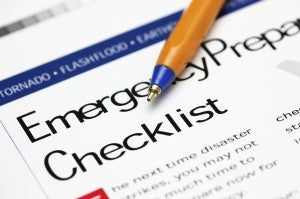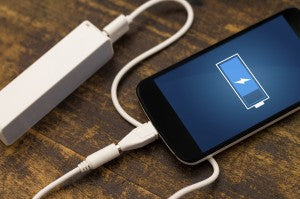
Last week, my family went to a minor league baseball game. We love these games because we can sit so close to the action. We were right above the bullpen.
One thing was strange. My 10-year-old special needs daughter kept asking, “Where’s the cannon?”
Finally, we identified the “cannon.” It was the sound of the baseball hitting the catcher’s glove.
We’re adding earplugs to her emergency preparedness bag.
The American Red Cross booklet, “Preparing for Disaster for People with Disabilities and other Special Needs,” offers six steps to be prepared.
Create a personal support network
A personal support network is a group of at least three people from every place a disabled person spends time. Their job is to help prepare and assist that person if disaster occurs.
They need to know the capabilities and special needs of the disabled person, like how to use a wheelchair or give medication, according to a FEMA pamphlet, “
Preparing Makes Sense for People with Disabilities and Special Needs.”
They also need to know the person’s evacuation plan. At least one other person should have a key to the disabled person’s home.
Complete a personal assessment
A personal assessment is a list of daily needs and resources. It includes questions like these from the National Organization on Disability. The questions help with planning.
- Do you use communication devices?
- Do you depend on accessible transportation?
- Do you receive medical treatments (e.g. dialysis) on a regular basis?
- Do you need assistance with personal care?
- Do you rely on electrical equipment or other durable equipment?
- Do you use mobility aids such as a walker, cane, or a wheelchair?
- Do you have a service animal?
Get informed about resources in your area
Disaster assistance resources include warning systems like reverse 911 and special needs registries.
The area where my family lives has a reverse 911 system. It’s easy to sign up for it; I enrolled using my smartphone while my husband and I were out running errands.
Many communities ask people with special needs to register with the fire or police department. Those who need electrical equipment also should register with the local utility company.
Make a plan
Actually, make two plans.

A communication plan includes contact information for family members and friends, work and school, and emergency organizations.
Ready.gov and
The Red Cross have forms for this information. Everyone should have an out-of-town contact because it’s often easier to make long distance calls after a disaster, according to the Red Cross booklet.
Families should also determine escape routes and emergency meeting places outside their home and neighborhood.
A woman from the U.S. who had trouble walking
described her escape plan to a United Nations disaster preparedness survey of people with disabilities. It started with having supplies loaded in her car.
“I would then put my cat in her carrier, go out to the car and drive up to my brother’s house, 10 miles north, where I will be helped by family members and be safe,” she wrote.
Assemble a kit
Brad and Robyn Mann, who write a column called
Sleeping with MS, described how they learned the importance of a disaster kit. Their town, more than 20 miles inland, flooded during Hurricane Irene in 2011.
First responders began evacuating the town. The Manns had 20 minutes to prepare.
“I panicked. We needed to assemble and pack essential clothing for four children, two adults, along with prescription medications and vital documents. All this needed to be ready in less time than it takes me to get dressed!” they wrote.
June Isaacson Kailes, a disability policy consultant, suggested packing two weeks’ worth of medical equipment.
“Make sure to pack enough medical supplies like syringes, ostomy bags, catheters and padding to last that long. Know what you are able to carry in a fanny pack, backpack or drawstring bag hung from a wheelchair, scooter or other assistive device. Do what is realistic for you,” she wrote.
Maintain the plan and the kit
Minor problems can become major events with my special needs daughter. Several months ago, a nearby transformer blew out. It was evening and rapidly getting dark. My daughter panicked. I had my cell phone and its flashlight, but only about 10 percent of charge remained.

Fortunately, I had a flashlight handy. Unfortunately its batteries were dead. By the rapidly diminishing power from my phone’s light, I found batteries and got it working. My daughter calmed down.
I learned three lessons. First, keep my phone charged (maybe I haven’t learned that one yet). Second, know where emergency equipment is and keep it in easy access. Third, make sure my emergency kit isn’t out of date.
Day-to-day life when dealing with special needs is exhausting. Yet it’s especially important for individuals with disabilities and their families to somehow Replace time and energy to prepare for emergencies.
The American woman with walking difficulty who was interviewed by the UN said being prepared helped her develop confidence.
“I must say that being this way … has been quite a learning experience as well as one for teaching myself how to be resourceful,” she wrote. “I may be slow, but I’ll always get there”
What are some other effective ways you've found in preparing for those who are disabled or have special needs? Let us know in comments!
 Last week, my family went to a minor league baseball game. We love these games because we can sit so close to the action. We were right above the bullpen.
One thing was strange. My 10-year-old special needs daughter kept asking, “Where’s the cannon?”
Finally, we identified the “cannon.” It was the sound of the baseball hitting the catcher’s glove.
We’re adding earplugs to her emergency preparedness bag.
The American Red Cross booklet, “Preparing for Disaster for People with Disabilities and other Special Needs,” offers six steps to be prepared.
Create a personal support network
A personal support network is a group of at least three people from every place a disabled person spends time. Their job is to help prepare and assist that person if disaster occurs.
They need to know the capabilities and special needs of the disabled person, like how to use a wheelchair or give medication, according to a FEMA pamphlet, “Preparing Makes Sense for People with Disabilities and Special Needs.”
They also need to know the person’s evacuation plan. At least one other person should have a key to the disabled person’s home.
Complete a personal assessment
A personal assessment is a list of daily needs and resources. It includes questions like these from the National Organization on Disability. The questions help with planning.
Last week, my family went to a minor league baseball game. We love these games because we can sit so close to the action. We were right above the bullpen.
One thing was strange. My 10-year-old special needs daughter kept asking, “Where’s the cannon?”
Finally, we identified the “cannon.” It was the sound of the baseball hitting the catcher’s glove.
We’re adding earplugs to her emergency preparedness bag.
The American Red Cross booklet, “Preparing for Disaster for People with Disabilities and other Special Needs,” offers six steps to be prepared.
Create a personal support network
A personal support network is a group of at least three people from every place a disabled person spends time. Their job is to help prepare and assist that person if disaster occurs.
They need to know the capabilities and special needs of the disabled person, like how to use a wheelchair or give medication, according to a FEMA pamphlet, “Preparing Makes Sense for People with Disabilities and Special Needs.”
They also need to know the person’s evacuation plan. At least one other person should have a key to the disabled person’s home.
Complete a personal assessment
A personal assessment is a list of daily needs and resources. It includes questions like these from the National Organization on Disability. The questions help with planning.
 A communication plan includes contact information for family members and friends, work and school, and emergency organizations. Ready.gov and The Red Cross have forms for this information. Everyone should have an out-of-town contact because it’s often easier to make long distance calls after a disaster, according to the Red Cross booklet.
Families should also determine escape routes and emergency meeting places outside their home and neighborhood.
A woman from the U.S. who had trouble walking described her escape plan to a United Nations disaster preparedness survey of people with disabilities. It started with having supplies loaded in her car.
“I would then put my cat in her carrier, go out to the car and drive up to my brother’s house, 10 miles north, where I will be helped by family members and be safe,” she wrote.
Assemble a kit
Brad and Robyn Mann, who write a column called Sleeping with MS, described how they learned the importance of a disaster kit. Their town, more than 20 miles inland, flooded during Hurricane Irene in 2011.
First responders began evacuating the town. The Manns had 20 minutes to prepare.
“I panicked. We needed to assemble and pack essential clothing for four children, two adults, along with prescription medications and vital documents. All this needed to be ready in less time than it takes me to get dressed!” they wrote.
June Isaacson Kailes, a disability policy consultant, suggested packing two weeks’ worth of medical equipment.
“Make sure to pack enough medical supplies like syringes, ostomy bags, catheters and padding to last that long. Know what you are able to carry in a fanny pack, backpack or drawstring bag hung from a wheelchair, scooter or other assistive device. Do what is realistic for you,” she wrote.
Maintain the plan and the kit
Minor problems can become major events with my special needs daughter. Several months ago, a nearby transformer blew out. It was evening and rapidly getting dark. My daughter panicked. I had my cell phone and its flashlight, but only about 10 percent of charge remained.
A communication plan includes contact information for family members and friends, work and school, and emergency organizations. Ready.gov and The Red Cross have forms for this information. Everyone should have an out-of-town contact because it’s often easier to make long distance calls after a disaster, according to the Red Cross booklet.
Families should also determine escape routes and emergency meeting places outside their home and neighborhood.
A woman from the U.S. who had trouble walking described her escape plan to a United Nations disaster preparedness survey of people with disabilities. It started with having supplies loaded in her car.
“I would then put my cat in her carrier, go out to the car and drive up to my brother’s house, 10 miles north, where I will be helped by family members and be safe,” she wrote.
Assemble a kit
Brad and Robyn Mann, who write a column called Sleeping with MS, described how they learned the importance of a disaster kit. Their town, more than 20 miles inland, flooded during Hurricane Irene in 2011.
First responders began evacuating the town. The Manns had 20 minutes to prepare.
“I panicked. We needed to assemble and pack essential clothing for four children, two adults, along with prescription medications and vital documents. All this needed to be ready in less time than it takes me to get dressed!” they wrote.
June Isaacson Kailes, a disability policy consultant, suggested packing two weeks’ worth of medical equipment.
“Make sure to pack enough medical supplies like syringes, ostomy bags, catheters and padding to last that long. Know what you are able to carry in a fanny pack, backpack or drawstring bag hung from a wheelchair, scooter or other assistive device. Do what is realistic for you,” she wrote.
Maintain the plan and the kit
Minor problems can become major events with my special needs daughter. Several months ago, a nearby transformer blew out. It was evening and rapidly getting dark. My daughter panicked. I had my cell phone and its flashlight, but only about 10 percent of charge remained.
 Fortunately, I had a flashlight handy. Unfortunately its batteries were dead. By the rapidly diminishing power from my phone’s light, I found batteries and got it working. My daughter calmed down.
I learned three lessons. First, keep my phone charged (maybe I haven’t learned that one yet). Second, know where emergency equipment is and keep it in easy access. Third, make sure my emergency kit isn’t out of date.
Day-to-day life when dealing with special needs is exhausting. Yet it’s especially important for individuals with disabilities and their families to somehow Replace time and energy to prepare for emergencies.
The American woman with walking difficulty who was interviewed by the UN said being prepared helped her develop confidence.
“I must say that being this way … has been quite a learning experience as well as one for teaching myself how to be resourceful,” she wrote. “I may be slow, but I’ll always get there”
What are some other effective ways you've found in preparing for those who are disabled or have special needs? Let us know in comments!
Fortunately, I had a flashlight handy. Unfortunately its batteries were dead. By the rapidly diminishing power from my phone’s light, I found batteries and got it working. My daughter calmed down.
I learned three lessons. First, keep my phone charged (maybe I haven’t learned that one yet). Second, know where emergency equipment is and keep it in easy access. Third, make sure my emergency kit isn’t out of date.
Day-to-day life when dealing with special needs is exhausting. Yet it’s especially important for individuals with disabilities and their families to somehow Replace time and energy to prepare for emergencies.
The American woman with walking difficulty who was interviewed by the UN said being prepared helped her develop confidence.
“I must say that being this way … has been quite a learning experience as well as one for teaching myself how to be resourceful,” she wrote. “I may be slow, but I’ll always get there”
What are some other effective ways you've found in preparing for those who are disabled or have special needs? Let us know in comments!


3 comments
Frank Davis
Learn how to build an evaporative cooler made with flower pots, sand, a towel and a DC fan that is powered by a small solar generator with battery backup.
The unit works by putting 2 different sized flower pots inside each other, fill the space between the pots with sand. Wet the sand until saturated. Place insulin inside inner flower pot. Wet and place towel over pot assembly and place fan so that it blows air across the pots and towel. As the water evaporates the inside pot will act as a cooler. Lowering the temperature around 20-30 degrees from the ambient temperature. So in summer best to set this up in a cool space like a basement and in winter leave it there too.
Now this is a last resort cooler when there is no power and all the ice is gone to prolong the life of the insulin. However, the life of the insulin will be reduced because of the higher temps. In a basement say it is 65 degrees then this cooler will possibly get down to around 45 degrees.
Another idea is to have a 4" hole bored in the earth to reach the depth where it stays in the 50’s all year long….cap it off with a PVC plumbing cap and use this as a storage space for the insulin when the power is off and the ice has been used up.
One more way to do this emergency cooling is to get an DC thermal unit “refrigerator/cooler” and purchase a battery backup solar generator and solar panel….this also has the drawbacks as the flower pots in that it will only cool down 30-40 degrees below ambient temperature so keep this in a cool place again like the basement.
These are last resort methods of keeping insulin and other meds that need to be cool because the life expectancy of the med will be shortened but it still can potentially save someone’s life verses just letting the insulin go bad in higher temps.
Linda Sand
Buy and charge a backup battery for my electric scooter. Nothing like getting halfway to your destination and having your battery die.
Henry
I am 100% dependent on Insulin, which must be kept cold. Always having ICE in the freezer, in order to keep my supply cold is a must.